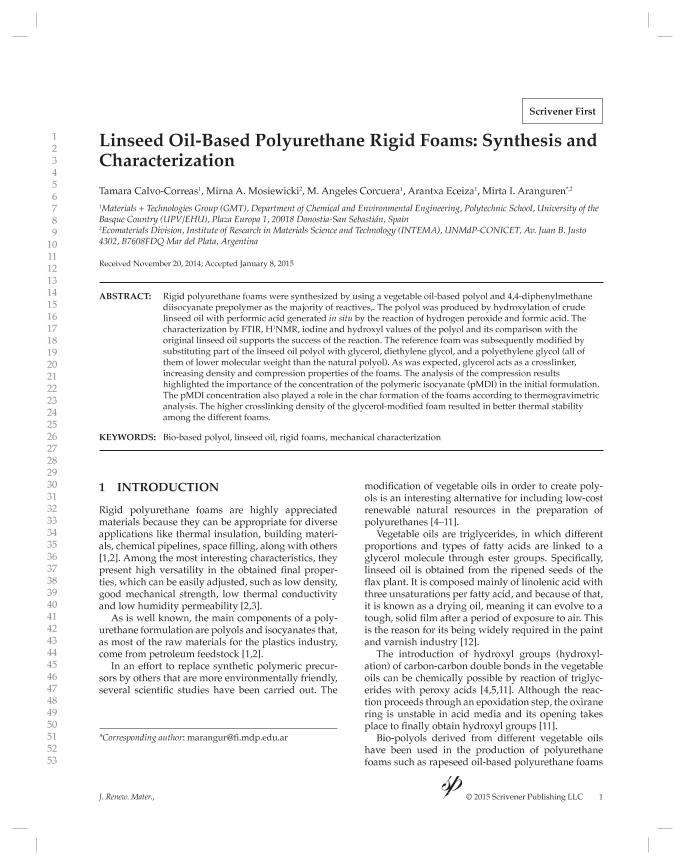Artículo
Linseed oil-based polyurethane rigid foams: synthesis and characterization
Calvo Correas, Tamara; Mosiewicki, Mirna Alejandra ; Corcuera, M. A.; Eceiza, Arantxa; Aranguren, Mirta Ines
; Corcuera, M. A.; Eceiza, Arantxa; Aranguren, Mirta Ines
 ; Corcuera, M. A.; Eceiza, Arantxa; Aranguren, Mirta Ines
; Corcuera, M. A.; Eceiza, Arantxa; Aranguren, Mirta Ines
Fecha de publicación:
01/03/2015
Editorial:
Scrivener Publishing
Revista:
Journal of Renewable Materials
ISSN:
2164-6325
Idioma:
Inglés
Tipo de recurso:
Artículo publicado
Clasificación temática:
Resumen
Rigid polyurethane foams were synthesized by using a vegetable oil-based polyol and 4,4-diphenylmethane diisocyanate prepolymer as the majority of reactives,. The polyol was produced by hydroxylation of crude linseed oil with performic acid generated in situ by the reaction of hydrogen peroxide and formic acid. The characterization by FTIR, H1NMR, iodine and hydroxyl values of the polyol and its comparison with the original linseed oil supports the success of the reaction. The reference foam was subsequently modified by substituting part of the linseed oil polyol with glycerol, diethylene glycol, and a polyethylene glycol (all of them of lower molecular weight than the natural polyol). As was expected, glycerol acts as a crosslinker, increasing density and compression properties of the foams. The analysis of the compression results highlighted the importance of the concentration of the polymeric isocyanate (pMDI) in the initial formulation. The pMDI concentration also played a role in the char formation of the foams according to thermogravimetric analysis. The higher crosslinking density of the glycerol-modified foam resulted in better thermal stability among the different foams.
Palabras clave:
BIO-BASED POLYOL
,
LINSEED OIL
,
MECHANICAL CHARACTERIZATION
,
RIGID FOAMS
Archivos asociados
Licencia
Identificadores
Colecciones
Articulos(INTEMA)
Articulos de INST.DE INV.EN CIENCIA Y TECNOL.MATERIALES (I)
Articulos de INST.DE INV.EN CIENCIA Y TECNOL.MATERIALES (I)
Citación
Calvo Correas, Tamara; Mosiewicki, Mirna Alejandra; Corcuera, M. A.; Eceiza, Arantxa; Aranguren, Mirta Ines; Linseed oil-based polyurethane rigid foams: synthesis and characterization; Scrivener Publishing; Journal of Renewable Materials; 3; 1; 1-3-2015; 3-13
Compartir
Altmétricas



